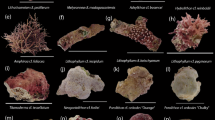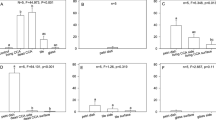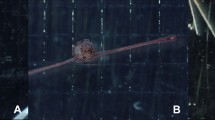Abstract
Degraded reefs with a high abundance of macroalgae usually also have low densities of coral recruits. Few studies, however, have examined whether these algae affect coral larval settlement. This study demonstrates, experimentally, that larvae of the Caribbean coral Favia fragrum can settle on the green alga Halimeda opuntia even when another substrate more suitable for settlement is present. Larval settlement onto experimental substrates was quantified under three treatments: rubble only, rubble plus plastic algal mimic, and rubble plus live H. opuntia. Similar total larval settlement was observed in all treatments. No larvae settled on the algal mimic, but total settlement was similar on the rubble in the first two treatments, showing that the rubble alone offered sufficient substrate for high settlement success. About half the larvae in the live algal treatment settled on H. opuntia instead of on the rubble, showing that larvae did not reject this substrate as they did the algal mimic. This result raises the possibility that corals will settle on some macroalgae when their abundance is high. Most macroalgae, including H. opuntia, are ephemeral substrates unsuitable for post-settlement survival. Such unexpected settlement may therefore have significant consequences for coral recruitment success on algal-dominated reefs.


Similar content being viewed by others
References
Bak RPM (1977) Coral reefs and their zonation in the Netherlands Antilles. AAPG Stud Geol 4:3–16
Beach K, Walters L, Borgeas H, Smith C, Coyer J, Vroom P (2003) The impact of Dictyota spp. on Halimeda populations of Conch Reef, Florida Keys. J Exp Mar Biol Ecol 297:141–159
Bellwood DR, Hughes TP, Folke C, Nyström M (2004) Confronting the coral reef crisis. Nature 429:827–833
Birrell CL, McCook LJ, Willis BL (2005) Effects of algal turfs and sediment on coral settlement. Mar Pollut Bull 51:408–414
Carlon DB, Olson RR (1993) Larval dispersal distance as an explanation for adult spatial pattern in two Caribbean reef corals. J Exp Mar Biol Ecol 173:247–263
Clifton KE (1997) Mass spawning by green algae on coral reefs. Science 275:1116–1118
Clifton KE, Clifton LM (1999) The phenology of sexual reproduction by green algae (Bryopsidales) on Caribbean coral reefs. J Phycol 35:24–34
Diaz-Pulido G, McCook LJ (2002) The fate of bleached corals: patterns and dynamics of algal recruitment. Mar Ecol Prog Ser 232:115–128
Gardner TA, Côtė IM, Gill JA, Grant A, Watkinson AR (2003) Long-term region-wide decline in Caribbean corals. Science 301:958–960
Harrington L, Fabricius K, De’ath G, Negri A (2004) Recognition and selection of settlement substrata determine post-settlement survival in corals. Ecology 85:3428–3437
Heyward AJ, Negri AP (1999) Natural inducers for coral larval metamorphosis. Coral Reefs 18:273–279
Hillis-Colinvaux L (1980) Ecology and taxanomy of Halimeda: primary producer of coral reefs. Adv Mar Biol 17:1–327
Hughes TP, Tanner JE (2000) Recruitment failure, life histories, and long-term decline of Caribbean corals. Ecology 81:2250–2263
Jompa J, McCook LJ (2002) Effects of competition and herbivory on interactions between a hard coral and a brown alga. J Exp Mar Biol Ecol 271:25–39
Jompa J, McCook LJ (2003) Coral-algal competition: macroalgae with different properties have different effects on corals. Mar Ecol Prog Ser 258:87–95
Kuffner IB, Walters LJ, Becerro MA, Paul VJ, Ritson-Williams R, Beach KS (2006) Inhibition of coral recruitment by macroalgae and cyanobacteria. Mar Ecol Prog Ser (in press)
Lirman D, Biber P (2000) Seasonal dynamics of macroalgal communities of the Northern Florida Reef Tract. Bot Mar 43:305–314
McClanahan TR, Muthiga NA (1998) An ecological shift in a remote coral atoll of Belize over 25 years. Environ Conserv 25:122–130
McCook LJ (1999) Macroalgae, nutrients and phase shifts on coral reefs: scientific issues and management consequences for the Great Barrier Reef. Coral Reefs 18:357–367
McCook LJ, Jompa J, Diaz-Pulido G (2001) Competition between corals and algae on coral reefs: a review of evidence and mechanisms. Coral Reefs 19:400–417
Merten MJ (1971) Ecological observations of Halimeda macrolobata Decaisne (Chlorophyta) on Guam. Micronesia 7:27–44
Morse DE, Hooker N, Morse ANC, Jensen RA (1988) Control of larval metamorphosis and recruitment in sympatric agariciid corals. J Exp Mar Biol Ecol 116:193–217
Negri AP, Webster NS, Hill RT, Heyward AJ (2001) Metamorphosis of broadcast spawning corals in response to bacteria isolated from crustose algae. Mar Ecol Prog Ser 223:121–131
Nugues MM, Bak RPM (2006) Differential competitive abilities between Caribbean coral species and a brown alga: a year of experiments and a long term perspective. Mar Ecol Prog Ser 315:75–86
Nugues MM, Smith GW, van Hooidonk RJ, Seabra MI, Bak RPM (2004) Algal contact as a trigger for coral disease. Ecol Lett 7:919–923
Paul VJ, van Alstyne KL (1992) Activation of chemical defenses in the tropical green algae Halimeda spp. J Exp Mar Biol Ecol 160:191–203
Petersen D, Laterveer M, Schuhmacher H (2005) Spatial and temporal variation in larval settlement of reefbuilding corals in mariculture. Aquaculture 249:317–327
Raimondi PT, Morse ANC (2000) The consequences of complex larval behavior in a coral. Ecology 81:3193–3211
River GF, Edmunds PJ (2001) Mechanisms of interaction between macroalgae and scleractinians on a coral reef in Jamaica. J Exp Mar Biol Ecol 261:159–172
Sammarco PW (1982) Polyp bail-out: an escape response to environmental stress and a new means of reproduction in corals. Mar Ecol Prog Ser 10:57–65
Shulman MJ, Robertson DR (1996) Changes in the coral reef of San Blas, Caribbean Panama: 1983 to 1990. Coral Reefs 15:231–236
Szmant-Froelich AM, Reutter M, Riggs L (1985) Sexual reproduction of Favia Fragrum (Esper): lunar patterns of gametogenesis, embryogenesis and planulation in Puerto Rico. Bull Mar Sci 37:880–892
Van Duyl FC (1985) Atlas of the living reefs of Curaçao and Bonaire (Netherlands Antilles). Foundation for Scientific Research in Surinam and the Netherlands Antilles, vol 117. Utrecht, the Netherlands, pp 1–63
Vermeij MJA, Bak RPM (2002) Corals on the move: rambling of Madracis pharensis polyps early after settlement. Coral Reefs 21:262–263
Vroom PS, Smith CM, Coyer JA, Walters LJ, Hunter CL, Beach KS, Smith JE (2003) Field biology of Halimeda tuna (Bryopsidales, Chlorophyta) across a depth gradient: comparative growth, survivorship, recruitment, and reproduction. Hydrobiologia 501:149–166
Walters LJ, Smith CM, Coyer JA, Hunter CL, Beach KS, Vroom PS (2002) Asexual propagation in the coral reef macroalga Halimeda (Chlorophyta, Bryosidales): production, dispersal and attachment of small fragments. J Exp Mar Biol Ecol 278:47–65
Walters LJ, Smith CM, Hadfield MG (2003) Recruitment of sessile marine invertebrates on Hawaiian macrophytes: do pre-settlement or post-settlement processes keep plant free from fouling? Bull Mar Sci 72:813–839
Webster NS, Smith LD, Heyward AJ, Watts JEM, Webb RI, Blackall LL, Negri AP (2004) Metamorphosis of a scleractinian coral in response to microbial biofilms. Appl Environ Microbiol 70:1213–1221
Williams ID, Polunin NVC (2001) Large scale associations between macroalgal cover and grazer biomass on mid-depth reefs in the Caribbean. Coral Reefs 19:358–366
Acknowledgements
We wish to thank the staff of the CARMABI research institute—especially Walter Bakhuis, Adolphe Debrot, Leon Pors, Bryan Leysner and Carlos Winterdaal—and the staff of the Office of International Program at UNCW. We are grateful to Daniel Nugues for assistance in the field and laboratory. Funding was provided by the Coral Reef Research programme at UNCW.
Author information
Authors and Affiliations
Corresponding author
Additional information
Communicated by Biology Editor H.R. Lasker
Rights and permissions
About this article
Cite this article
Nugues, M.M., Szmant, A.M. Coral settlement onto Halimeda opuntia: a fatal attraction to an ephemeral substrate?. Coral Reefs 25, 585–591 (2006). https://doi.org/10.1007/s00338-006-0147-0
Received:
Accepted:
Published:
Issue Date:
DOI: https://doi.org/10.1007/s00338-006-0147-0




